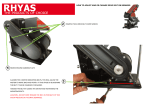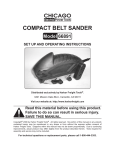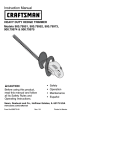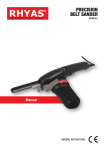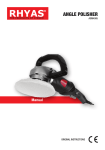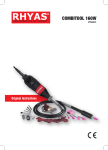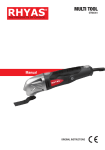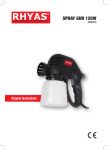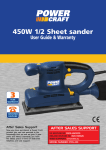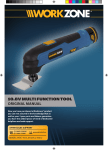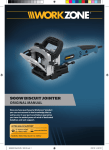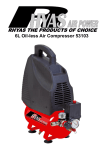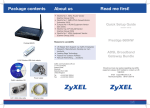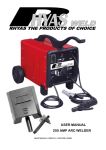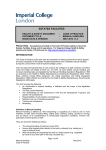Download BENCH SANDER 375W
Transcript
BENCH SANDER 375W BGM4005 Original Instructions EN 6 5 4 8 10 11 9 2 7 1 Fig. 1 Fig. 2 2 3 13 12 14 EN Fig. 3 Fig. 4 Fig. 5 3 EN Fig. 6 15 Fig. 7 Fig. 8 4 EN BENCH SANDER BGM4005 Thank you for buying this Rhyas product. By doing so you now have an excellent product, delivered by one of Europes leading suppliers. All products delivered to you by Rhyas are manufactured according to the highest standards of performance and safety. As part of our philosophy we also provide an excellent customer service, backed by our comprehensive Warranty. We hope you will enjoy using this product for many years to come. The numbers in the following text refer to the drawing on page 2-4 ead the operating instructions R carefully before using this device. Familiarize yourself with its functions and basic operation. Service the device as per the instructions to ensure that it always functions properly. The operating instructions and the accompanying documentation must be kept in the vicinity of the device. Description This machine combines all the advantages of a horizontal and a vertical belt sander with those of a disc sander. Its sturdy construction in cast iron and steel makes the machine suitable for every sanding job. Contents: 1. Technical specification 2. Safety instructions 3. Before putting the machine into operation 4. Putting the machine into operation 5.Maintenance 1. Technical specification Machine data Voltage 230 V, 50 Hz Power input 375 W S2= 30 min* No load speed sander belt 276 m/min No load speed sander disc 1450 /min Sanding belt size 915 x 100 mm Sanding disc size Ø 150 mm Weight 16.5 kg Lpa (Sound pressure level) 79+3 dB(A) Lwa (Sound power level) 92+3 dB(A) *S2= Maximum period of operation with a capacity of 375 W Vibration level The vibration emission level stated in this instruction manual has been measured in accordance with a standardised test given in EN 60745; it may be used to compare one tool with another and as a preliminary assessment of exposure to vibration when using the tool for the applications mentioned •using the tool for different applications, or with different or poorly maintainted accessories, may significantly increase the exposure level •the times when the tool is switched off or when it is running but not actually doing the job, may signifi cantly reduce the exposure level Protect yourself against the effects of vibration by maintaining the tool and its accessories, keeping your hands warm, and organizing your work patterns List of parts Fig.1 + 6 1. Machine frame 2.Motor 3. Roller stop and parallel stop 4. Clamping handle 5. Transport roller 6. Sanding belt 7 On/off switch 8.Fence 9. Drive roller 10.Aluminium disc 11. Sanding disc 12.Work plate 13.Mitre scale 14.Supporting arm 2. Safety instructions Explanation of the symbols enotes risk of personal injury, loss of D life or damage to the tool in case of nonobservance of the instructions in this manual. Indicates electrical shock hazard. 5 EN Wear ear and eye protection wear a dustmask Keep bystanders away Special safety instructions • The following points need to be checked: • Do the connecting voltage of the machine correspond with the mains voltage. • Are the mains lead and the mains plug in a good condition; strong, without ravels or damages. • For functional reasons the turning parts of this machine are not covered. Therefore it is of utmost importance to be careful. Hold the workpiece firmly, to prevent it from slipping from your hands. Never touch the sanding surfaces of a working machine with your hands. • Avoid the use of long extension cables. • If necessary, secure the sanding machine with screws. Before you operate the machine: • Always keep the mains cable away from moving parts of the machine. • Use safety goggles. • Use a dust mask. Electrical safety When using electric machines always observe the safety regulations applicable in your country to reduce the risk of fire, electric shock and personal injury. Read the following safety instructions and also the enclosed safety instructions. Always check that the power supply corresponds to the voltage on the rating plate. Replacing cables or plugs Immediately throw away old cables or plugs when they have been replaced by new ones. It is dangerous to insert the plug of a loose cable in the wall outlet. 6 Using extension cables Only use an approved extension cable suitable for the power input of the machine. The minimum conductor size is 1.5 mm2. When using a cable reel always unwind the reel completely. Immediately switch off the machine when: • Excessive sparking of the carbon brushes and verticiliosis in the collector. • Interruption of the mains plug, mains lead or mains lead damage. • Defect switch • Smoke or stench of scorched isolation 3. Before putting the machine into operation Installation Avoid the use of long extension cables. If necessary, secure the sanding machine on a working bench with help of screws through the holes in the feet of the machine frame. Do not forget to leave enough space around the machine for the workpieces to be sanded. Assembly • Put the machine frame on its head and press the four rubber stops into the foot of the frame. • Machine frame, aluminium disc (10) and work plate (12) are supplied in separate packaging. • Push the aluminium disc on the shaft and fasten the disc with the socket bolt in the side of the disc (Fig.2 - 4). • Place the work plate (12) with the shaft in the machine frame and secure the work plate with the bolt in the side of the machine frame. Check with a 90° sash angle on the work plate and against the sanding disc if the angle is exactly 90° (Fig.5). • If necessary, adjust this angle with the calibration indicator. • The mitre scale (13), which is also supplied separately, can be placed on the work plate (12). With the use of this mitre scale the angle of grinding can be determined precisely. • The fence (8) for the belt sander can be placed behind the uppermost bolt of the V-belt guard. In this way the workpiece can be held firmly against the belt, without great hazards. EN o prevent the workpiece or your fingers T from getting caught between the work plate (12) and the sanding disc (11), the space between work plate (12) and sanding disc (11) must not exceed 1.6 mm. The choice of sanding paper With coarse sanding paper (P 60) generally most of the material can be removed, and fine sanding paper (P 150) is then used for finishing. An uneven surface is first treated with coarse sanding paper and sanded until it is even. Subsequently medium-coarse sanding paper (P 100) is used to remove the scratches caused by the first type of paper used. Fine sanding paper (P 150) is used for finishing. The sanding needs to be continued until the surface is smooth. The placing of the sanding paper Fig. 6 - 9 When the sanding machine is held with the sanding disc turned towards you, the sanding belt moves from right to left along the upper part of the machine. Because of this turning direction the workpiece will be pressed against the right side of the fence. An arrow on the inside indicates the right direction of running of the sanding belt (see drawing). If no direction is indicated, the sanding belt must be placed in such a way that the elevated part of the seam is placed into the turning direction of the belt. So it is very important that the sanding belt is placed in the correct way. The machine uses standard 100 x 915 mm sanding belts (nr 7): • Remove the plug from the mains socket. • Push the clamping handle completely to the right to take away the tension of the transport rollers (Fig.1: 14). • Push the sanding belt along both of the transport rollers, starting from the back of the machine. • Push the clamping handle completely to the left. Now the sanding belt should be completely tight. • Turn the transport roller exactly in a right angle to the direction of the sanding belts with the use of the winged nut at the right roller. The direction of running of the belt is adjusted correctly if the sides of the sanding belt are running parallel to the bearing plate. The sanding disc Paper or “velcro” plates are used for the sanding disc. The standard diameter is 150 mm. The plates are self adhesive. Vertical placing of the sanding belt For more flexibility of the sanding belt its bottom side can be used, because there is no bearing plate. For an easy reach of this bottom side the sanding belt can be placed in vertical position. • Loosen the two nuts at the front of the sanding machine, around the left transport roller shaft, with the use of an open-end spanner. • Push the sanding belt up in the position desired. • Fasten the two nuts again. • The workpiece can now rest on the worktop instead of on the sanding belt; • The work plate which is used for the sanding disc can now be pushed with the shaft into the hole of the machine frame, at the left side of the sanding machine. • Fasten the bolt at the back of the machine. • The work plate can now be used as support for the sanding of the work piece against the sanding belt. 4. Putting the machine into operation Switching On/Off • Press the switch into position ‘1’ to put your sanding machine into operation. • To switch off the machine the same switch needs to be pressed to position ‘0’. • Always keep the mains cable away from moving parts. • There is no need to apply any pressure with the workpiece, because this only slows down the speed of the sanding disc. Sanding The sanding belt and disc supplied with this sanding machine are suitable for the sanding of metal, wood or synthetic surfaces. The workpiece should always be held firmly during sanding. No extra pressure is needed. Guide the work piece up and down over the sanding belt, in order to prevent the sanding belt and plate from wearing through in one place. Round objects can be sanded at the ends of the sanding belt. Work pieces which are longer than the sanding machine can be sanded by removing the fence. 7 EN NB: To prevent splintering, wood always needs to be sanded in the longitudinal direction of the grain. To treat a very soft surface, there is a very handy method to ‘bring the particles to the surface’. This is done as follows: wet the already sanded surface with a cloth or sponge and let it dry well. Some wood fibres will swell up more than others, which leads to a rougher surface than before. Now the higher particles are treated with fine sanding paper, the result is a remarkably smooth surface. This method should not be applied with varnished wood, however, because the varnish may come loose because of the moisture. 5. Maintenance Make sure that the machine is not live when carrying out maintenance work on the motor. The Rhyas machines have been designed to operate over a long period of time with a minimum of maintenance. Continuous satisfactory operation depends upon proper machine care and regular cleaning. Malfunction Below we have listed a number of possible causes and corresponding solutions in case the machine does not function as it should: he electromotor gets hot T • The cool ventilation slots in the motor are stopped up with dirt. • Clean the cool ventilation slots. • The motor is defective. • Have your sanding machine repaired / checked at your local Rhyas dealer. The connected machine does not work. • Interruption in the mains connection. • Check mains connection for fracture. Have your sanding machine repaired / checked at your local Rhyas dealer. Periodic maintance of the belt sander will prevent unnecessary problems! 8 Cleaning Never use water or other agressive liquids to clean the machine. Clean the machine by brushing it with a brush. Keep the ventilation slots of the machine clean to prevent overheating of the motor. Lubrication There is no need to lubricate the transport rollers of the machine. Faults Should a fault occur, e.g. after wear of a part, please contact the service address on the warranty card. In the back of this manual you find an exploded view showing the parts that can be ordered. Environment To prevent damage during transport, the appliance is delivered in a solid packaging which consists largely of reusable material. Therefore please make use of options for recycling the packaging. Faulty and/or discarded electrical or electronic apparatus have to be collected at the appropriate recycling locations. Warranty For the warranty conditions read the warranty card at the back of these instructions for use. The product and the user manual are subject to change. Specifications can be changed without further notice. EN 9 EN Spare parts list BGM4005 No.Description 402832 Aluminium disc 800210 V-belt 402833 Motor pulley 402834 Driven pulley 402835 Rubber foot 402836 Switch 806201 Bearing 6201 zz 402837 Idler roller 402838 Adjustment bolt 402839 Driver roller 402840 Mitre gauge 10 Position 5 12 13 14 28 31 43 44 48,49 56 64,65,68 EN 11 EN GENERAL SAFETY INSTRUCTIONS Warning! Read all instructions. Failure to follow all instructions listed below may result in electric shock, fire and/or serious injury. The term “power tool” in all of the warnings listed below refers to your mains operated (corded) power tool or battery operated (cordless) power tool. Save these instructions. 1) Work area a.Keep work area clean and well lit. Cluttered and dark areas invite accidents. b.Do not operate power tools in explosive atmospheres, such as in the presence of flammable liquids, gasses or dust. Power tools create sparks which may ignite the dust of fumes. c.Keep children and bystanders away while operating a power tool. Distractions can cause you to lose control. 2) Electrical safety a.Power tool plugs must match the outlet. Never modify the plug in any way. Do not use any adapter plugs which earthed (grounded) power tools. Unmodified plugs and matching outlets will reduce risk of electric shock. b.Avoid body contact with earthed or grounded surfaces such as pipes, radiators, ranges and refrigerators. There is an increased risk of electric shock if your body is earthed or grounded. c.Do not expose power tools to rain or wet conditions. Water entering a power tool will increase the risk of electric shock. d.Do not abuse the cord. Never use the cord for carrying, pulling or unplugging the power tool. Keep cord away from heat, oil, sharp edges or moving parts. Damaged or entangled cords increase the risk of electric shock. e.When operating a power tool outdoors, use an extension cord suitable for outdoor use. Use of a cord suitable for outdoor use reduces the risk of electric shock. Always use tool in conjunction with a residual circuit breaker device. 3) Personal safety a.Stay alert, watch what you are doing and use common sense when operating a power tool. Do not use a power tool while you are tired or under the influence of drugs, alcohol or medication. A moment of inattention while operating power tools may result in serious personal injury. b.Use safety equipment. Always wear eye protection. Safety equipment such as dust mask, non-skid safety shoes, hard hat, or hearing protection used for appropriate conditions will reduce personal injuries. 12 c.Avoid accidental starting. Ensure the switch is in the off position before plugging in. Carrying power tools with your finger on the switch or plugging in power tools that have the switch on invites accidents. d.Remove any adjusting key or wrench before turning the power tool on. A wrench or a key left attached to a rotating part of the power tool may result in personal injury. e.Do not overreach. Keep proper footing and balance at all times. This enables better control of the power tool in unexpected situations. f.Dress properly. Do not wear loose clothing or jewellery. Keep your hair, clothing and gloves away from moving parts. Loose clothes, jewellery or long hair can be caught in moving parts. g.If devices are provided for the connection of dust extraction and collection facilities, ensure these are connected and properly used. Use of these devices can reduce dust related hazards. h.Use clamps or a vice to hold work. It’s safer than using your hand and it frees both hands to operate tool. 4) Power tool use and care a.Do not force the power tool. Use the correct power tool for your application. The correct power tool will do the job better and safer at the rate for which it was designed. b.Do not use the power tool if the switch does not turn it on and off. Any power tool that cannot be controlled with the switch is dangerous and must be repaired. c.Disconnect the plug from the power source before making any adjustments, changing accessories, or storing power tools. Such preventive safety measures reduce the risk of starting the power tool accidentally. d.Store idle power tools out of the reach of children and do not allow persons unfamiliar with the power tool or these instructions to operate the power tool. Power tools are dangerous in the hands of untrained users. e.Maintain power tools. Check for misalignment or binding of moving parts, breakage of parts and any other condition that may affect the power tools operation. If damaged, have the power tool repaired before use. Many accidents are caused by poorly maintained power tools. f.Keep cutting tools sharp and clean. Properly maintained cutting tools with sharp cutting edges are less likely to bind and are easier to control. g.Use the power tool, accessories and tool bits etc., in accordance with these instructions and in the manner intended for the particular type of power tool, taking into account the working conditions and the work to be performed. Use of the power tool for operations different from intended could result in hazardous situation. EN h.Damaged switches must be replaced at a customer service repair centre. Do not use power tools that cannot be switched on and off. i.Do not leave power tools unattended while they are switched on. Always switch off the tool and wait until it has come to a full standstill before leaving. j.If the mains cable has been damaged, it must be replaced with a special mains cable. These can be obtained from the manufacturer or the manufacturer’s customer service department. The mains cable may only be replaced by the manufacturer, the manufacturer’s customer service department or equally qualified persons. c.Use power tools only with specifically designated battery packs. Use of any other battery packs may create a risk of injury and fire. d.When battery pack is not in use, keep it away from other metal objects like paper clips, coins, keys, nails, screws, or other small metal objects that can make a connection from one terminal to another. Shorting the battery terminals together may cause burns of a fire. e.Under abusive conditions, liquid may be ejected from the battery; avoid contact. If contact accidentally occurs, flush with water. If liquid contacts eyes, additionally seek medical help. Liquid ejected from the battery may cause irritations or burns. 5) Battery tool use and care a.Ensure the switch is in the off position before inserting battery pack. Inserting the battery pack into power tools that have the switch on invites accidents. b.Recharge only with the charger specified by the manufacturer. A charger that is suitable for one type of battery pack may create a risk of fire when used with another battery pack. 6)Service a.Please use a qualified expert who uses original replacement parts to repair your power tool. This will ensure proper functioning of the power tool. b.Caution! The use of any accessories or additional tools other than those recommended in this manual may lead to an increased risk of injury. Only use original replacement parts. DECLARATION OF CONFORMITY BGM4005 (EN) We declare under our sole responsibility that this product is in conformity with directive 2011/65/EU of the European parliament and of the council of 9 June on the restriction of the use of certain hazardous substances in electrical and electronic equipment is in conformity and accordance with the following standards and regulations: EN 55014-1, EN 55014-2-16, EN 51044-1, EN 50144-2, EN 61000-3-2, EN 61000-3-3 2006/42/EC, 2006/95/EC, 2004/108/EC, 2002/96/EC, 2006/95/EC Zwolle, 01-05-2014 W. Dekens CEO Mactool Industrial BV It is our policy to continuously improve our products and we therefore reserve the right to change the product specification without prior notice. Mactool Industrial BV • Lingenstraat 6 • 8028 PM • Zwolle The Netherlands 13 1405-02
















